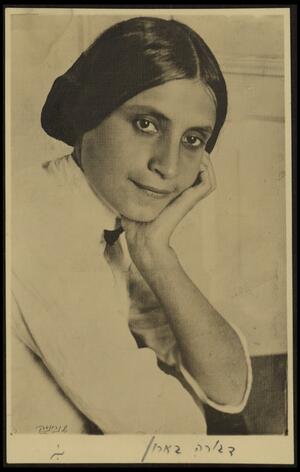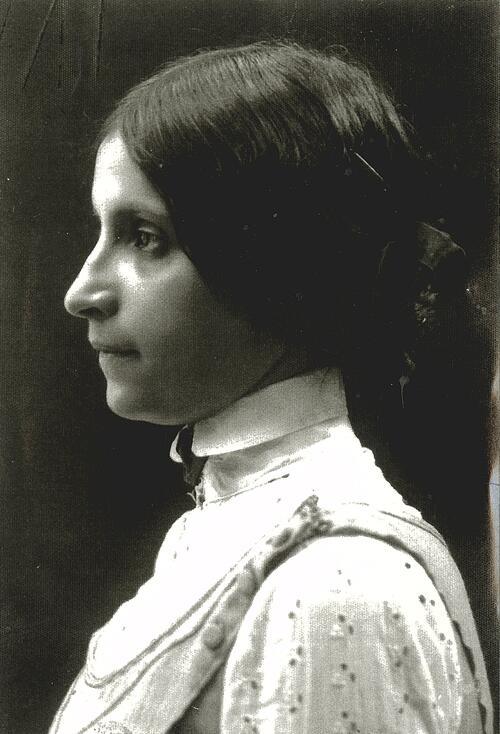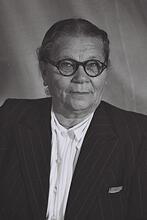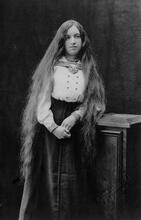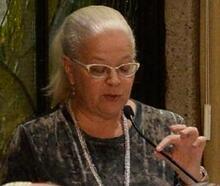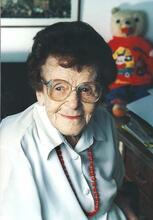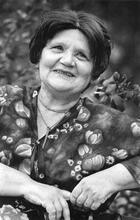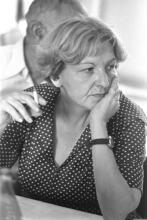Devorah Baron
Devorah Baron was the most recognized Hebrew women prose writer in the first half of the twentieth century. She wrote about Jewish women’s lives, focusing on the challenges women faced in a society that did not value them equally. She was born in the small town of Uzda, outside of Minsk, to a rabbi father who educated his daughter in Hebrew. She emigrated to Palestine in 1910, where she became the book editor of the Zionist Socialist newspaper Ha-poel ha-tsair (The Young Worker). In 1911 she married the chief editor Yosef Aharonovitz. In 1922, a few years after she returned from exile in Egypt, she and her husband resigned their editorial position, and she secluded herself in her home, from where she continued to write until her death in 1956.
Devorah Baron was a masterful prose writer, whose singular style set her apart from the Hebrew writing of her time. Although sometimes mistakenly referred to as the first Hebrew woman writer, she is one of the few women whose works have been incorporated into the canon of pre-state Hebrew literature. Baron’s prose fiction describes the everyday lives of Jewish women in the small towns of Eastern Europe and the new Jewish settlements in Ottoman and later Mandatory Palestine, offering a feminist and socialist perspective on twentieth-century Jewish life. She often wrote from the narrative point-of-view of a rabbi’s daughter, offering sympathetic portrayals of the difficult lives of Jewish women. Her stories intersperse the interior worlds of her characters with descriptions of their everyday lives and are rich with allusions to traditional Jewish sources and European literature. She experimented with a range of narrative perspectives, pushing Hebrew narrative form in new directions.
Early Years
Baron was born on December 4, 1887, in the small town of Uzda (50 km SSW of Minsk), where her father served as a rabbi. She was the third of five children. Only she and her older sister Haya-Rivkah immigrated to Palestine, while the rest of the family perished. Her brother Benjamin, a physician, served in the Russian Army in World War I and died of typhoid in 1919 or 1920. Her sister Zipporah, after whom Devorah Baron named her only daughter, married a rabbi and died two years after her wedding. Hanna died in the Holocaust.
As a young girl, Baron demonstrated unusual interest, skill, and persistence in studying Torah she-bi-khetav: Lit. "the written Torah." The Bible; the Pentateuch; Tanakh (the Pentateuch, Prophets and Hagiographia)Torah and The legal corpus of Jewish laws and observances as prescribed in the Torah and interpreted by rabbinic authorities, beginning with those of the Mishnah and Talmud.halakhah. Her father allowed her to follow in her brother’s footsteps and acquire a thorough Jewish-Hebrew education, seated in the women’s section behind the partition in the synagogue. Like other Hebrew women writers of her generation, such as Chava Shapira, her access to Hebrew depended on the support of family members willing to flout educational conventions.
At the age of fifteen, Baron, chaperoned by her brother Benjamin, set out to pursue a secular education in Minsk and Kovno, where she established her reputation as a Hebrew and Yiddish writer. Her independence was highly unusual for a Jewish woman of her background; she completed her high school education as an external student and made a living as a tutor, often living in her students’ homes. She gained acceptance in both Hebrew and Yiddish literary circles in this period.
Early Career
Devorah Baron started to write short stories in Yiddish in 1902, when she was just fourteen. Her work created an immediate sensation because of her age and her sex. Many believed that she was a man writing under a female pseudonym. Her stories included “forbidden” topics such as love and sex and were critical of traditional Jewish family life. Some years later, Baron’s fiancé, the author Moshe Ben-Eliezer (1882–1944), broke off their engagement, supposedly because of Baron’s personal autonomy and the outspoken manner of her literary expression.
In 1910, after her father died, her (Yiddish) Small-town Jewish community in Eastern Europe.shtetl was destroyed in a pogrom, and her engagement ended, Devorah Baron immigrated to Palestine. By the time she left Europe for Palestine, Baron had a well-established literary reputation as a sought-after writer in both the Hebrew and Yiddish press, with a collection of short stories in the works.
Baron’s early Hebrew and Yiddish stories depict the world of the shtetl from the point of view of women suffering under patriarchal norms. Her narrators, often rabbis’ daughters, are narrators and witnesses to the difficulties faced in their own lives or those of the women around them. In “Place for storing books or ritual objects which have become unusable.Genizah” (“Burying the Books”), a narrator records her memories of preparing for the ritual burial of holy books. In one memory she recalls setting aside her mother’s tear-stained collection of tkhines (Yiddish women’s prayers) for burial, when her brother tosses them aside referring to the book as “rags.” The scene is followed by an apocalyptic dream sequence in which the mother, resurrected from the dead, searches for her beloved book, while her daughter tosses them into an open grave of Hebrew books. The tension in the story between the mother’s attachment to the living Yiddish, and her daughter’s desire to bury the Yiddish prayers, captures the complexities of Baron’s own position as a modern Hebrew writer choosing a language her mother would not be able to read, offering a narrative of Hebrew modernity from the perspective of women. Her early stories explore social violence against women. In “Liska,” we see a group of young girls execute a supposedly “Jewish” dog as punishment for its uncontrolled sexual appetite. Her stories capture the small and large indignities of women's everyday domestic and marital lives in the shtetl.
When Baron arrived in Palestine, instead of working in a labor collectives as many of her contemporaries did, she immediately took up a position at Ha-poel ha-tsair (The Young Worker), a Hebrew newspaper that was the organ of the Zionist Socialist movement of the same name. Shortly thereafter, in October 1911, she married the paper’s editor-in-chief, Yosef Aharonovich; their only daughter, Zipporah, was born in Tel Aviv in 1914. Baron edited the paper’s literary pages until the family’s exile to Alexandria by Ottoman authorities in 1915.
Seclusion and Mature Career
Returning to Palestine in 1919, after the end of World War I and the establishment of the British Mandate, Baron continued to work for the newspaper until she and her husband abruptly resigned in 1922. She subsequently dedicated herself solely to her literary career, continuing to write fiction from her self-imposed seclusion. Though she secluded herself in her home, she did not cut her ties with Hebrew literary culture. Rather Hebrew writers came to her bed side.
After her immigration to Palestine, Baron stopped writing in Yiddish. Her mature fiction continued on the themes of her earlier work, describing the difficulties of women’s lives in the shtetl and also in Palestine. Writing from her home in Tel Aviv, she grappled with her distance from the world of Eastern Europe, a world whose destruction from World War I onward haunted her writing. Baron’s narrative style matured, intricately weaving complex narrative perspectives, rich literary allusion, and a keen eye for detail. In her work, she sustained a robust dialogue with European writers, particularly Flaubert and Chekhov, as well the Nobel Prize-winning Hebrew author S. Y. Agnon. Although Baron’s work has often been read as lyrical and nostalgic for a lost Jewish past, her stories of this period show the dark side of women’s lives, even as they capture her feelings of loss. These stories focus on domestic labor and offer reflections on the role of women as artists and creators. In her short story “Ketanot” (“Trifles”), Baron enters an extended dialogue with Flaubert’s Madame Bovary, offering a feminist rewriting that imagines Emma’s desire as a productive artistic force, while also documenting the violence and poverty that limit women’s lives. Baron wrote stories about Jewish life in Palestine. In “Ziva,” for example, she describes the lives of young Yemenite house maids, abused wives, and an abandoned Hebrew-speaking dog. Whether describing women’s lives in Lit. (Greek) "dispersion." The Jewish community, and its areas of residence, outside Erez Israel.Diaspora or in Israel, Baron captures her protagonists’ poignant struggles for freedom and fulfillment, their desires to realize the fruits of their labor and to thrive, often against great odds.
Baron continued to write stories that documented women’s lives in the shtetl and in Palestine and also pushed Hebrew literature in new modernist directions. Despite her prominent role in Hebrew letters, her first book-length collection did not appear until 1927, when she was forty years old, a remarkable delay for such a well-regarded writer. Operating in a literary world, dominated by male editors and critics, she faced frustrations and disappointments that made their way into her stories of women’s domestic labors.
It was during the later part of her life that Baron completed several important literary translations, including Flaubert’s Madame Bovary. She sustained a lengthy literary dialogue with Flaubert’s work in the 1930s.
All told, Devorah Baron published about 80 short stories and a novella entitled Exiles. In later years, Baron referred to her early stories as “rags” and refused to include them in the various collections of her stories that started to appear in 1927.
Devorah Baron lived in Tel Aviv till her death on August 20, 1956. She brought her unique socialist, feminist aesthetic project to Hebrew letters. Her work continues to be read and admired by Hebrew audiences and in English translation.
Selected Works
The First Day and Other Stories. Translated by Naomi Seidman and Chana Kronfeld, Berkeley, CA: 2001
The Thorny Path. Translated by Itzhak Hanoch. Jerusalem: Institute for the Translation of Hebrew Literature, 1969.
Aharonovitz, Zipporah. By the Way (Hebrew). Merhavyah: 1961.
The daughter’s version of her mother’s brief biography, with a collection of short episodes of her mother’s life and sayings. This book also includes some unpublished stories of the author and friends’ recollections of her.
Govrin, Nurit. Devorah Baron, Early Chapters (Hebrew). Jerusalem: 1988.
A detailed biography of the first half of Baron’s life, with complete list of her stories and a thorough literary review of her work. In this volume, Govrin rediscovered and published Baron’s early uncollected stories in Hebrew and Yiddish, which allows for a comparison with the author’s later, better known, work.
Jelen, Sheila. Intimations of Difference: Dvora Baron in the Modern Hebrew Renaissance. Syracuse: Syracuse University Press, 2007.
A thoughtful study of Devora Baron’s oeuvre that moves beyond the biographical psychological impulses illuminating the nuanced ways Baron adopted and subverted Hebrew literary norms. She offers important readings of Baron’s narrative perspectives, her modernist practices, and her relationship to realism. She includes new translations of two stories, “In What World” and “As a Driven Leaf.”
Jelen, Sheila and Shachar Pinsker. Hebrew, Gender, and Modernity: Critical Responses to Dvora Baron’s Fiction. Lanham, MD: University Press of Maryland, 2007.
This collection of essays offers a range of new approaches to the work of Dvora Baron, reading her as an important modernist Hebrew writer.
Lieblich, Amia. Embroideries (Hebrew) Tel Aviv: 1991.
A literary psychobiography of Baron, written as twenty-four (fictional) conversations between Baron and Lieblich, which supposedly took place during Baron’s last year of life in Tel Aviv. Using the available historical evidence, and assuming the autobiographical nature of most of her stories, Lieblich reconstructed Baron’s life story, cultural background, views and experiences.
Lieblich, Amia. Conversations with Dvora: An Experimental Biography of the First Modern Hebrew Woman Writer. Berkeley, CA: University of California Press, 1997.
An English adapted translation of the above, translated by Naomi Seidman.
Seidman, Naomi. A Marriage Made in Heaven: The Sexual Politics of Hebrew and Yiddish. Berkeley, CA: University of California Press, 1997.
Seidman examines Baron’s place in Hebrew letters as a woman writer writing outside tradition, while also cloaking herself in the very tradition that excluded her. She illuminates Baron’s rich engagement with European, Hebrew modernist, and traditional Jewish texts, reading both her Hebrew and Yiddish writings together, to make of the gendered politics of both languages.
Zierler, Wendy. And Rachel Stole the Idols: The Emergence of Modern Hebrew Women’s Writing. Detroit: Wayne State University Press, 2004.
This book offers an analysis of several of Baron’s stories and situates Baron in the larger context of Hebrew women’s writing, reminding us that Baron’s work was not singular, but part of a larger dialogue of women writers with modern Hebrew and Jewish traditional texts.

